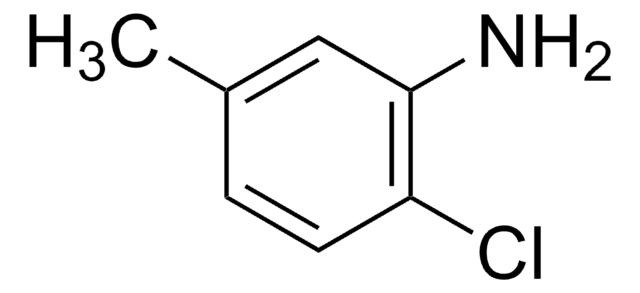102253
2,5-Dimethylaniline
99%
Sinonimo/i:
2,5-Xylidine, 2-Amino-1,4-dimethylbenzene, 2-Amino-p-xylene
Scegli un formato
About This Item
Prodotti consigliati
Livello qualitativo
Saggio
99%
Indice di rifrazione
n20/D 1.559 (lit.)
P. ebollizione
218 °C (lit.)
Punto di fusione
11.5 °C (lit.)
Densità
0.973 g/mL at 25 °C (lit.)
Stringa SMILE
Cc1ccc(C)c(N)c1
InChI
1S/C8H11N/c1-6-3-4-7(2)8(9)5-6/h3-5H,9H2,1-2H3
VOWZNBNDMFLQGM-UHFFFAOYSA-N
Cerchi prodotti simili? Visita Guida al confronto tra prodotti
Categorie correlate
Descrizione generale
Avvertenze
Danger
Indicazioni di pericolo
Consigli di prudenza
Classi di pericolo
Acute Tox. 3 Dermal - Acute Tox. 3 Inhalation - Acute Tox. 3 Oral - Aquatic Chronic 2 - STOT RE 2
Codice della classe di stoccaggio
6.1A - Combustible acute toxic Cat. 1 and 2 / very toxic hazardous materials
Classe di pericolosità dell'acqua (WGK)
WGK 3
Punto d’infiammabilità (°F)
204.8 °F - closed cup
Punto d’infiammabilità (°C)
96 °C - closed cup
Dispositivi di protezione individuale
Eyeshields, Faceshields, Gloves, type ABEK (EN14387) respirator filter
Scegli una delle versioni più recenti:
Possiedi già questo prodotto?
I documenti relativi ai prodotti acquistati recentemente sono disponibili nell’Archivio dei documenti.
I clienti hanno visto anche
Active Filters
Il team dei nostri ricercatori vanta grande esperienza in tutte le aree della ricerca quali Life Science, scienza dei materiali, sintesi chimica, cromatografia, discipline analitiche, ecc..
Contatta l'Assistenza Tecnica.

















